Harnessing AI and Sustainable Materials for Greener, Smarter Buildings: A Bibliometric Study
Abstract
1. Introduction
- Discovery of innovative eco-friendly insulation materials, which hold the potential to significantly enhance thermal performance and reduce energy consumption.
- Reduction in greenhouse gas emissions through the development and use of environmentally sustainable materials.
- Optimization of computational efficiency for predicting building energy consumption by refining AI algorithms, thereby increasing the accuracy of energy performance forecasts.
2. Literature Review
2.1. The Contribution of Bio-Based Materials to Energy Efficiency
2.2. Contributions of AI Methods to Energy Efficiency
| Author | System Analyzed | ML Model | Remarks |
|---|---|---|---|
| H. Yan et al. [41] | Optimizing building performance | XGBOOST | XGBOOST demonstrated the best performance in transfer learning, with R2 = 0.95, MAE = 1.17, and MSE = 4.56 for high-consumption buildings. |
| Li and Yao [42] | Prediction of heating and cooling loads for residential buildings | SVR and LR | SVR with a radial basis function kernel achieved the best performance, with a MAE of 4.40 and an RMSE of 6.28. |
| K. Huang et al. [43] | Passenger thermal comfort in subway compartments | LR, RF, SVM, DT | Random Forest outperformed others with an R2 of 0.6607 for predicting passenger TSV values. |
| Karatasou et al. [44] | Hourly energy loads | ANN | Empirical results showed prediction accuracy comparable to the best documented in the existing literature. |
| Kajl et al. [45] | Energy consumption for buildings | ANN | Fuzzy logic was used for post-processing ANN results to adjust the influence of various building attributes on annual and monthly energy consumption. |
| Dong et al. [7] | Forecasting monthly electricity consumption | SVM | SVMs proved to be particularly effective in addressing this specific problem, with MSE values varying by building: Building A showed the highest MSE (0.73), while Building D recorded the lowest (0.14). |
| Marani and Nehadi [46] | Integration of phase-change materials in cement composites | RF, ETR, GBR, XGBOOST | A dataset of 154 cement mixtures with PCM was used, with Gradient Boosting showing the highest precision (R2 = 0.977) and RMSE and AMAE values of 2.419 and 1.752, respectively. |
| Liang and Du [47] | Fault detection and diagnosis for HVAC systems using a combined physical model with SVM | SVM | A four-layer SVM classifier effectively identifies normal conditions and three possible faults, achieving up to 100% accuracy on both test sets, even with a limited number of training samples. |
| Luong Duc Long et al. [35] | Optimization of building energy design from early phases | Gradient Boosting | The study highlighted significant savings in both cost and energy consumption—7.52% and 8.48%, respectively, for Vietnam—with high predictive performance (R2 = 0.994, RMSE = 1.19, MAE = 0.50). |
| Y. Boutahri et al. [48] | Prediction of thermal comfort levels and optimization of energy consumption in HVAC systems | SVM, ANN, XGBOOST, RF | The RF and XGBOOST algorithms demonstrated superior performance, achieving accuracies of 96.7% (MAE = 0.021, RMSE = 0.073) and 96.4% (MAE = 0.01, RMSE = 0.076), respectively. In contrast, the SVM performed less well, with an R2 of 81.1% (MAE = 0.083, RMSE = 0.18). |
| Dnyandip K. Bhamare et al. [49] | Prediction of thermal performance of roofs with PCM integration | RF, XGBOOST, ETR, GBR, Catboost, ANN | The Gradient Boosting regression model outperforms other machine learning models in terms of performance, with an R2 of 97.92, MAE of 0.23, and RMSE of 0.374. |
2.3. The Assessment of Building Energy Efficiency
Summary of the Literature Review
- Bio-Based Insulation Materials
- B.
- Artificial Intelligence (AI) in Energy Management
- C.
- Integrative Approaches and Future Prospects
- D.
- Research Gaps and Future Directions
3. Bibliometric Analysis
3.1. Methodology
3.1.1. Publication Search
3.1.2. Data Gathering
3.1.3. Data Management and Statistical Assessment
3.2. Bibliometric Results
3.2.1. Descriptive Data Analysis
3.2.2. Volume of Scientific Publications
3.2.3. Publications Categorized by Countries, Sources, Affiliations, Authors, and Keywords
- i.
- Most influential sources and authors
- ii.
- Top contributing countries
- iii.
- Scientific production by source
- iv.
- Scientific contribution by affiliation
- v.
- Scientific publications by author
- vi.
- The attributes of keywords
3.2.4. The Thematic Evolution of Research
3.2.5. Cluster Analysis: Bibliographic Coupling of Journals, Countries, and Keyword Co-Occurrence, and Author Co-Citation
- ➢
- Interpretative Discussion of Clustered Results
4. Research Gap and Problem Statement
5. Conclusions
Author Contributions
Funding
Data Availability Statement
Conflicts of Interest
References
- Buildings-Energy System. IEA. Available online: https://www.iea.org/energy-system/buildings (accessed on 9 August 2024).
- Milena, T.; Serikbaevna, B.A. Application of optimal steam and thermal insulation materials to improve the energy efficiency of buildings. Constr. Archit. 2023, 11, 9. [Google Scholar] [CrossRef]
- Chetty, A.; Arukala, S.R. Development of Framework for Achieving Optimum Thermal Insulation for Building Infrastructures. In Low Carbon Materials and Technologies for a Sustainable and Resilient Infrastructure; Pancharathi, R.K., Leung, C.K.Y., Chandra Kishen, J.M., Eds.; Springer Nature: Singapore, 2024; pp. 247–261. [Google Scholar] [CrossRef]
- Binici, H.; Aksogan, O.; Demirhan, C. Mechanical, thermal and acoustical characterizations of an insulation composite made of bio-based materials. Sustain. Cities Soc. 2016, 20, 17–26. [Google Scholar] [CrossRef]
- Yildirim, N. Performance Comparison of Bio-based Thermal Insulation Foam Board with Petroleum-based Foam Boards on the Market. BioResources 2018, 13, 3395–3403. [Google Scholar] [CrossRef]
- Catalina, T.; Virgone, J.; Blanco, E. Development and validation of regression models to predict monthly heating demand for residential buildings. Energy Build. 2008, 40, 1825–1832. [Google Scholar] [CrossRef]
- Dong, B.; Cao, C.; Lee, S.E. Applying support vector machines to predict building energy consumption in tropical region. Energy Build. 2005, 37, 545–553. [Google Scholar] [CrossRef]
- Lotka, A.J. The Frequency Distribution of Scientific Productivity on JSTOR. Available online: https://www.jstor.org/stable/24529203?seq=4 (accessed on 15 August 2024).
- Samuelsson, C. Relating Turing’s Formula and Zipf’s Law. arXiv 1996, arXiv:cmp-lg/9606013. [Google Scholar] [CrossRef]
- Glanzel, W. Bibliometrics as a Research Field: A Course on Theory and Application of Bibliometric Indicators; Bib_Module_KUL. 2003; Available online: https://www.cin.ufpe.br/~ajhol/futuro/references/01%23_Bibliometrics_Module_KUL_BIBLIOMETRICS%20AS%20A%20RESEARCH%20FIELD.pdf (accessed on 15 August 2024).
- Ellegaard, O.; Wallin, J.A. The bibliometric analysis of scholarly production: How great is the impact? Scientometrics 2015, 105, 1809–1831. [Google Scholar] [CrossRef]
- Zeng, R.; Chini, A. A review of research on embodied energy of buildings using bibliometric analysis. Energy Build. 2017, 155, 172–184. [Google Scholar] [CrossRef]
- Fellah, M.; Ouhaibi, S.; Belouaggadia, N.; Mansouri, K.; Zahiri, L. Numerical study of a new ecological material in moroccan climate: CFD approach. In Proceedings of the 3rd International Conference on Innovative Research in Applied Science, Engineering and Technology (IRASET), Casablanca, Morocco, 18–19 May 2023. [Google Scholar] [CrossRef]
- Liu, L.; Li, H.; Lazzaretto, A.; Manente, G.; Tong, C.; Liu, Q.; Li, N. The development history and prospects of biomass-based insulation materials for buildings. Renew. Sustain. Energy Rev. 2017, 69, 912–932. [Google Scholar] [CrossRef]
- Yang, Y. Bio-Based Flame Retardant for Sustainable Building Materials. Ph.D. Thesis, Universitat Politècnica de Catalunya, Barcelona, Spain, 2019. [Google Scholar] [CrossRef]
- Cárdenas-R, J.P.; Cea, M.; Santín, K.; Valdés, G.; Hunter, R.; Navia, R. Characterization and application of a natural polymer obtained from Hydrangea macrophylla as a thermal insulation biomaterial. Compos. Part B Eng. 2018, 132, 10–16. [Google Scholar] [CrossRef]
- Limam, A.; Zerizer, A.; Quenard, D.; Sallee, H.; Chenak, A. Experimental thermal characterization of bio-based materials (Aleppo Pine wood, cork and their composites) for building insulation. Energy Build. 2016, 116, 89–95. [Google Scholar] [CrossRef]
- Zarmehr, S.P.; Kazemi, M.; Madasu, N.G.A.; Lamanna, A.J.; Fini, E.H. Application of bio-based polyurethanes in construction: A state-of-the-art review. Resour. Conserv. Recycl. 2025, 212, 107906. [Google Scholar] [CrossRef]
- Barreca, F.; Cardinali, G.; Barbaresi, A.; Bovo, M. Bio-based building components: A newly sustainable solution for traditional walls made of Arundo donax and gypsum. Heat Transfer. 2023, 52, 5166–5183. [Google Scholar] [CrossRef]
- Tola, A. Bio-construction and Renewable Raw Materials: The Case of Cork. In Pathways to Environmental Sustainability: Methodologies and Expériences; Salomone, R., Saija, G., Eds.; Springer International Publishing: Cham, Switzerland, 2014; pp. 137–146. [Google Scholar] [CrossRef]
- Eshrar, L.; Bevan, R.; Woolley, T. Thermal Insulation Materials for Building Applications-Eshrar Latif|Rachel Bevan|Tom Woolley; Emerald Publishing: Bingley, UK, 2019; Available online: https://bookstore.emerald.com/thermal-insulation-materials-for-building-applications-pb.html (accessed on 15 August 2024).
- Sterflinger, K.; Ettenauer, J.; Piñar, G. Bio-susceptibility of Materials and Thermal Insulation Systems used for Historical Buildings. Energy Procedia 2013, 40, 499–506. [Google Scholar] [CrossRef]
- Chikhi, M.; Agoudjil, B.; Boudenne, A.; Gherabli, A. Experimental investigation of new biocomposite with low cost for thermal insulation. Energy Build. 2013, 66, 267–273. [Google Scholar] [CrossRef]
- Asdrubali, F.; D’Alessandro, F.; Schiavoni, S. A review of unconventional sustainable building insulation materials. Sustain. Mater. Technol. 2015, 4, 1–17. [Google Scholar] [CrossRef]
- Boumhaout, M.; Boukhattem, L.; Hamdi, H.; Benhamou, B.; Nouh, F.A. Thermomechanical characterization of a bio-composite building material: Mortar reinforced with date palm fibers mesh. Constr. Build. Mater. 2017, 135, 241–250. [Google Scholar] [CrossRef]
- Le, D.L.; Salomone, R.; Nguyen, Q.T.; Versele, A.; Piccardo, C. Status and barriers to circular bio-based building material adoption in developed economies: The case of Flanders, Belgium. J. Environ. Manag. 2024, 367, 121965. [Google Scholar] [CrossRef] [PubMed]
- Mouton, L.; Allacker, K.; Röck, M. Bio-based building material solutions for environmental benefits over conventional construction products–Life cycle assessment of regenerative design strategies (1/2). Energy Build. 2023, 282, 112767. [Google Scholar] [CrossRef]
- Florez, D.; Perré, P.; Segovia, C.; Rémond, R. Computational characterisation of the heat flow meter method applied to moist bio-based insulating building materials. Int. J. Therm. Sci. 2024, 201, 109038. [Google Scholar] [CrossRef]
- Öztürk, G.; Temiz, A.; Hekimoğlu, G.; Aslan, M.; Demirel, G.K.; Erdeyer, Ö.N.; Sarı, A.; Gencel, O.; Subaşı, S. Microencapsulated phase change material/wood fiber-starch composite as novel bio-based energy storage material for buildings. J. Energy Storage 2024, 84, 110911. [Google Scholar] [CrossRef]
- Dong, Y.; Liu, B.; Lee, S.H.; Lum, W.C.; Ren, Y.; Zhou, X.; Wang, H.; Zhou, B.; Zhang, J. Fabrication of rigid flame retardant foam using bio-based sucrose-furanic resin for building material applications. Chem. Eng. J. 2024, 495, 153614. [Google Scholar] [CrossRef]
- Galimshina, A.; Moustapha, M.; Hollberg, A.; Padey, P.; Lasvaux, S.; Sudret, B.; Habert, G. Bio-based materials as a robust solution for building renovation: A case study. Appl. Energy 2022, 316, 119102. [Google Scholar] [CrossRef]
- Fellah, M.; Ouhaibi, S.; Belouaggadia, N.; Mansouri, K. Harnessing machine learning for enhanced thermal insulation and energy efficiency in buildings worldwide. Results Eng. 2025, 25, 104086. [Google Scholar] [CrossRef]
- Li, T.; Bie, H.; Lu, Y.; Sawyer, A.O.; Loftness, V. MEBA: AI-powered precise building monthly energy benchmarking approach. Appl. Energy 2024, 359, 122716. [Google Scholar] [CrossRef]
- Gnekpe, C.; Tchuente, D.; Nyawa, S.; Dey, P.K. Energy Performance of Building Refurbishments: Predictive and Prescriptive AI-based Machine Learning Approaches. J. Bus. Res. 2024, 183, 114821. [Google Scholar] [CrossRef]
- Long, L.D. An AI-driven model for predicting and optimizing energy-efficient building envelopes. Alex. Eng. J. 2023, 79, 480–501. [Google Scholar] [CrossRef]
- Khan, S.U.; Khan, N.; Ullah, F.U.M.; Kim, M.J.; Lee, M.Y.; Baik, S.W. Towards intelligent building energy management: AI-based framework for power consumption and generation forecasting. Energy Build. 2022, 279, 112705. [Google Scholar] [CrossRef]
- Ngarambe, J.; Yun, G.Y.; Santamouris, M. The use of artificial intelligence (AI) methods in the prediction of thermal comfort in buildings: Energy implications of AI-based thermal comfort controls. Energy Build. 2020, 211, 109807. [Google Scholar] [CrossRef]
- Chen, C.-Y.; Chai, K.K.; Lau, E. AI-Assisted approach for building energy and carbon footprint modeling. Energy AI 2021, 5, 100091. [Google Scholar] [CrossRef]
- Yussuf, R.O.; Asfour, O.S. Applications of artificial intelligence for energy efficiency throughout the building lifecycle: An overview. Energy Build. 2024, 305, 113903. [Google Scholar] [CrossRef]
- Xu, K.; Chen, Z.; Xiao, F.; Zhang, J.; Zhang, H.; Ma, T. Semantic model-based large-scale deployment of AI-driven building management applications. Autom. Constr. 2024, 165, 105579. [Google Scholar] [CrossRef]
- Yan, H.; Ji, G.; Yan, K. Data-driven prediction and optimization of residential building performance in Singapore considering the impact of climate change. Build. Environ. 2022, 226, 109735. [Google Scholar] [CrossRef]
- Li, X.; Yao, R. A machine-learning-based approach to predict residential annual space heating and cooling loads considering occupant behaviour. Energy 2020, 212, 118676. [Google Scholar] [CrossRef]
- Huang, K.; Lu, S.; Li, X.; Chen, W. Using random forests to predict passengers’ thermal comfort in underground train carriages. Indoor Built Environ. 2022, 32, 343–354. [Google Scholar] [CrossRef]
- Karatasou, S.; Santamouris, M.; Geros, V. Modeling and predicting building’s energy use with artificial neural networks: Methods and results. Energy Build. 2006, 38, 949–958. [Google Scholar] [CrossRef]
- Kajl, S.; Poulin, R.; Malinowski, P.; Roberge, M.-A. Fuzzy Assistant for Evaluation of Building Energy Consumption. In Proceedings of the 4th IFSICC—International Fuzzy Systems and Intelligent Control Conference, Maui, HI, USA, 8–11 April 1996; pp. 67–74. Available online: https://espace2.etsmtl.ca/id/eprint/11076/ (accessed on 25 August 2024).
- Marani, A.; Nehdi, M.L. Machine learning prediction of compressive strength for phase change materials integrated cementitious composites. Constr. Build. Mater. 2020, 265, 120286. [Google Scholar] [CrossRef]
- Liang, J.; Du, R. Model-based Fault Detection and Diagnosis of HVAC systems using Support Vector Machine method. Int. J. Refrig. 2007, 30, 1104–1114. [Google Scholar] [CrossRef]
- Boutahri, Y.; Tilioua, A. Machine learning-based predictive model for thermal comfort and energy optimization in smart buildings. Results Eng. 2024, 22, 102148. [Google Scholar] [CrossRef]
- Bhamare, D.K.; Saikia, P.; Rathod, M.K.; Rakshit, D.; Banerjee, J. A machine learning and deep learning based approach to predict the thermal performance of phase change material integrated building envelope. Build. Environ. 2021, 199, 107927. [Google Scholar] [CrossRef]
- Kapoor, G.; Singhal, M. Impact of innovative thermal insulation materials in the building envelope on energy efficiency of residential buildings. Mater. Today Proc. 2024, in press. [Google Scholar] [CrossRef]
- Kadi, Y.; Korichi, A.; Maalouf, C. Improving building energy efficiency and thermal comfort with natural fibre insulation. Proc. Inst. Civ. Eng. Eng. Sustain. 2023, 177, 230–241. [Google Scholar] [CrossRef]
- Wang, S.; Li, C.; Zhang, W.; Sui, J.; Negnevitsky, M. Assessing the impact of prefabricated buildings on urban green total factor energy efficiency. Energy 2024, 297, 131239. [Google Scholar] [CrossRef]
- Escrivá-Escrivá, G.; Álvarez-Bel, C.; Peñalvo-López, E. New indices to assess building energy efficiency at the use stage. Energy Build. 2011, 43, 476–484. [Google Scholar] [CrossRef]
- Lakatos, Á. Novel Thermal Insulation Materials for Buildings. Energies 2022, 15, 6713. [Google Scholar] [CrossRef]
- Pisello, A.L.; Goretti, M.; Cotana, F. A method for assessing buildings’ energy efficiency by dynamic simulation and experimental activity. Appl. Energy 2012, 97, 419–429. [Google Scholar] [CrossRef]
- Okokpujie, I.P.; Essien, V.; Ikumapayi, O.M.; Nnochiri, E.S.; Okokpujie, K.; Akinlabi, E. An Overview of Thermal Insulation Material for Sustainable Engineering Building Application. Int. J. Des. Nat. Ecodynamics 2022, 17, 831–841. [Google Scholar] [CrossRef]
- Zhukov, A. Energy Efficiency of Building Systems. INFRA-M-Editorum Publishing Group. Available online: https://naukaru.ru/en/nauka/monography/2437/view (accessed on 25 August 2024).
- Wang, J.; Li, Z.; Zhou, T.; Deng, W.; Liang, R.; Lun, I.Y.-F.; Li, Y.; Bao, R. Global assessment of radiative cooling and low-emissivity coatings for energy efficiency in buildings across all climate zones. Energy Build. 2024, 317, 114402. [Google Scholar] [CrossRef]
- Paraschiv, L.S.; Acomi, N.; Serban, A.; Paraschiv, S. A web application for analysis of heat transfer through building walls and calculation of optimal insulation thickness. Energy Rep. 2020, 6, 343–353. [Google Scholar] [CrossRef]
- Hassan, M.E. The Influence of Thermal Insulation on Cooling a Residential Building in Khartoum. Available online: https://onlinejournals.uofk.edu/index.php/kuej/article/view/900 (accessed on 29 August 2024).
- Ashrafian, T. Enhancing school buildings energy efficiency under climate change: A comprehensive analysis of energy, cost, and comfort factors. J. Build. Eng. 2023, 80, 107969. [Google Scholar] [CrossRef]
- Egnatosyan, S.; Hakobyan, D.; Sargsyan, S. Comparative Analysis of the Use of Thermal Insulation Materials Depending on Climatic Conditions and Comfort Microclimate Supply Systems. Key Eng. Mater. 2022, 906, 99–106. [Google Scholar] [CrossRef]
- Siciliano, A.P.; Zhao, X.; Fedderwitz, R.; Ramakrishnan, K.; Dai, J.; Gong, A.; Zhu, J.Y.; Kośny, J.; Hu, L. Sustainable Wood-Waste-Based Thermal Insulation Foam for Building Energy Efficiency. Buildings 2023, 13, 840. [Google Scholar] [CrossRef]
- Khitab, A.; Abdin, Z.U.; Ahmed, I.; Karim, T. 8-Thermal insulation of buildings through classical materials and nanomaterials. In Recent Advances in Nano-Tailored Multi-Functional Cementitious Composites; Şahmaran, M., Shaikh, F., Yıldırım, G., Eds.; Woodhead Publishing Series in Civil and Structural Engineering; Woodhead Publishing: Sawston, UK, 2022; pp. 277–303. [Google Scholar] [CrossRef]
- Hamooleh, M.B.; Torabi, A.; Baghoolizadeh, M. Multi-objective optimization of energy and thermal comfort using insulation and phase change materials in residential buildings. Build. Environ. 2024, 262, 111774. [Google Scholar] [CrossRef]
- Alla, S.A.; Bianco, V.; Scarpa, F.; Tagliafico, L.A. Retrofitting for Improving Energy Efficiency: The Embodied Energy Relevance for Buildings’ Thermal Insulation. In Proceedings of the ASME 2020 14th International Conference on Energy Sustainability, Virtual, 17–18 June 2020. [Google Scholar] [CrossRef]
- Paraschiv, S.; Paraschiv, L.S.; Serban, A. Increasing the energy efficiency of a building by thermal insulation to reduce the thermal load of the micro-combined cooling, heating and power system. Energy Rep. 2021, 7, 286–298. [Google Scholar] [CrossRef]
- Danaci, H.M.; Akin, N. Thermal insulation materials in architecture: A comparative test study with aerogel and rock wool. Environ. Sci. Pollut. Res. 2022, 29, 72979–72990. [Google Scholar] [CrossRef]
- Kaya, R.; Caglayan, S. Potential Benefits of Thermal Insulation in Public Buildings: Case of a University Building. Buildings 2023, 13, 2586. [Google Scholar] [CrossRef]
- Ma, W.; Fan, J.; Fang, S.; Hassan, N.; Zhang, Y.; Wu, X.; Li, Y.; Hu, R.; Liu, G. Energy efficiency indicators for combined cooling, heating and power systems. Energy Convers. Manag. 2021, 239, 114187. [Google Scholar] [CrossRef]
- Kaya, D.; Çanka Kılıç, F.; Öztürk, H.H. Energy Saving with Heat Insulation. In Energy Management and Energy Efficiency in Industry: Practical Examples; Kaya, D., Çanka Kılıç, F., Öztürk, H.H., Eds.; Springer International Publishing: Cham, Switzerland, 2021; pp. 443–462. [Google Scholar] [CrossRef]
- El-Awadly, R.; Abdel-Rehim, A. Performance and economical analysis of different insulating materials used to reduce the heat load of an existing residential building. Mech. Eng. 2021, 17, 155–166. [Google Scholar] [CrossRef]
- Agouzoul, A.; Simeu, E.; Tabaa, M. Advancing Sustainable Building Practices: Intelligent Methods for Enhancing Heating and Cooling Energy Efficiency. Sustainability 2024, 16, 2879. [Google Scholar] [CrossRef]
- Tien Bui, D.; Moayedi, H.; Anastasios, D.; Kok Foong, L. Predicting Heating and Cooling Loads in Energy-Efficient Buildings Using Two Hybrid Intelligent Models. Appl. Sci. 2019, 9, 3543. [Google Scholar] [CrossRef]
- Makrygiannis, I.; Karalis, K. Optimizing Building Thermal Insulation: The Impact of Brick Geometry and Thermal Coefficient on Energy Efficiency and Comfort. Ceramics 2023, 6, 1449–1466. [Google Scholar] [CrossRef]
- Sajjad, M.; Khan, S.U.; Khan, N.; Haq, I.U.; Ullah, A.; Lee, M.Y.; Baik, S.W. Towards Efficient Building Designing: Heating and Cooling Load Prediction via Multi-Output Model. Sensors 2020, 20, 6419. [Google Scholar] [CrossRef]
- Guz, A.N.; Rushchitsky, J.J. Scopus: A system for the evaluation of scientific journals. Int. Appl. Mech. 2009, 45, 351–362. [Google Scholar] [CrossRef]
- Bergman, E.M.L. Finding Citations to Social Work Literature: The Relative Benefits of Using Web of Science, Scopus, or Google Scholar. J. Acad. Librariansh. 2012, 38, 370–379. [Google Scholar] [CrossRef]
- Meho, L.I. Using Scopus’s CiteScore for assessing the quality of computer science conferences. J. Informetr. 2019, 13, 419–433. [Google Scholar] [CrossRef]
- Hirsch, J.E. An index to quantify an individual’s scientific research output. Proc. Natl. Acad. Sci. USA 2005, 102, 16569–16572. [Google Scholar] [CrossRef] [PubMed]
- Egghe, L. Theory and practise of the g-index. Scientometrics 2006, 69, 131–152. [Google Scholar] [CrossRef]
- Bornmann, L.; Mutz, R.; Daniel, H.-D. Are there better indices for evaluation purposes than the index? A comparison of nine different variants of the index using data from biomedicine. J. Am. Soc. Inf. Sci. Technol. 2008, 59, 830–837. [Google Scholar] [CrossRef]
- Röck, M.; Saade, M.R.M.; Balouktsi, M.; Rasmussen, F.N.; Birgisdottir, H.; Frischknecht, R.; Habert, G.; Lützkendorf, T.; Passer, A. Embodied GHG emissions of buildings–The hidden challenge for effective climate change mitigation. Appl. Energy 2019, 258, 114107. [Google Scholar] [CrossRef]
- Röck, M.; Hollberg, A.; Habert, G.; Passer, A. LCA and BIM: Visualization of environmental potentials in building construction at early design stages. Build. Environ. 2018, 140, 153–161. [Google Scholar] [CrossRef]
- Laborel-Préneron, A.; Aubert, J.E.; Magniont, C.; Tribout, C.; Bertron, A. Plant aggregates and fibers in earth construction materials: A review. Constr. Build. Mater. 2016, 111, 719–734. [Google Scholar] [CrossRef]
- Cagnon, H.; Aubert, J.E.; Coutand, M.; Magniont, C. Hygrothermal properties of earth bricks. Energy Build. 2014, 80, 208–217. [Google Scholar] [CrossRef]
- Zhang, J.; Yu, Q.; Zheng, F.; Long, C.; Lu, Z.; Duan, Z. Comparing keywords plus of WOS and author keywords: A case study of patient adherence research. J. Assoc. Inf. Sci. Technol. 2016, 67, 967–972. [Google Scholar] [CrossRef]
- Shinde, S.N.; Christa, S.; Grover, R.K.; Pasha, N.; Harinder, D.; Nakkeeran, G.; Alaneme, G.U. Optimization of waste plastic fiber concrete with recycled coarse aggregate using RSM and ANN. Sci. Rep. 2025, 15, 7798. [Google Scholar] [CrossRef]
- Benzaama, M.H.; Boudenne, A.; Benzarti, K. A machine learning and deep learning approach to the identification of heat transfer and phase change phenomena in cement mortar walls filled with bio-based PCM. J. Energy Storage 2025, 121, 116540. [Google Scholar] [CrossRef]
- Mizrak, F.; Yaşar, O. Strategic deployment of piezoelectric energy harvesting in smart urban infrastructure: A hybrid QPFRS, M-SWARA, K-means clustering, and PROMETHEE evaluation for sustainable advantage. Energy Rep. 2025, 13, 2565–2582. [Google Scholar] [CrossRef]
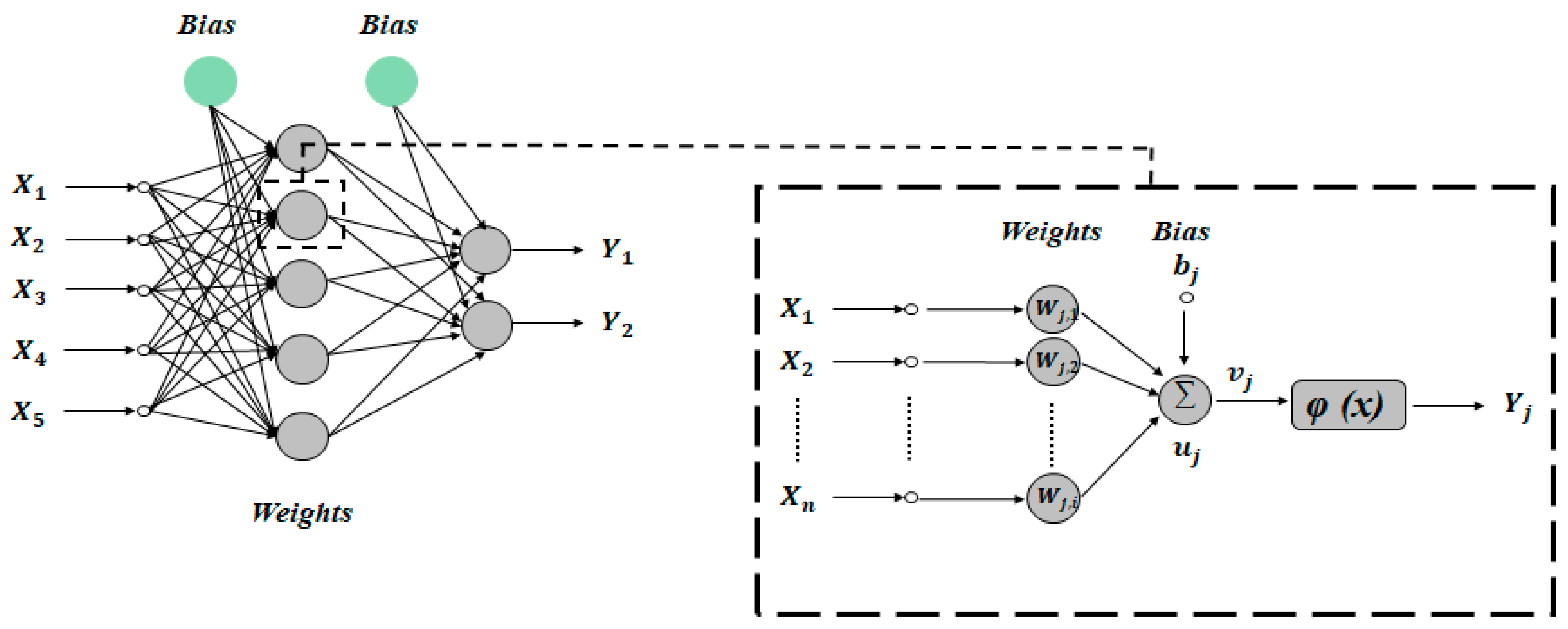
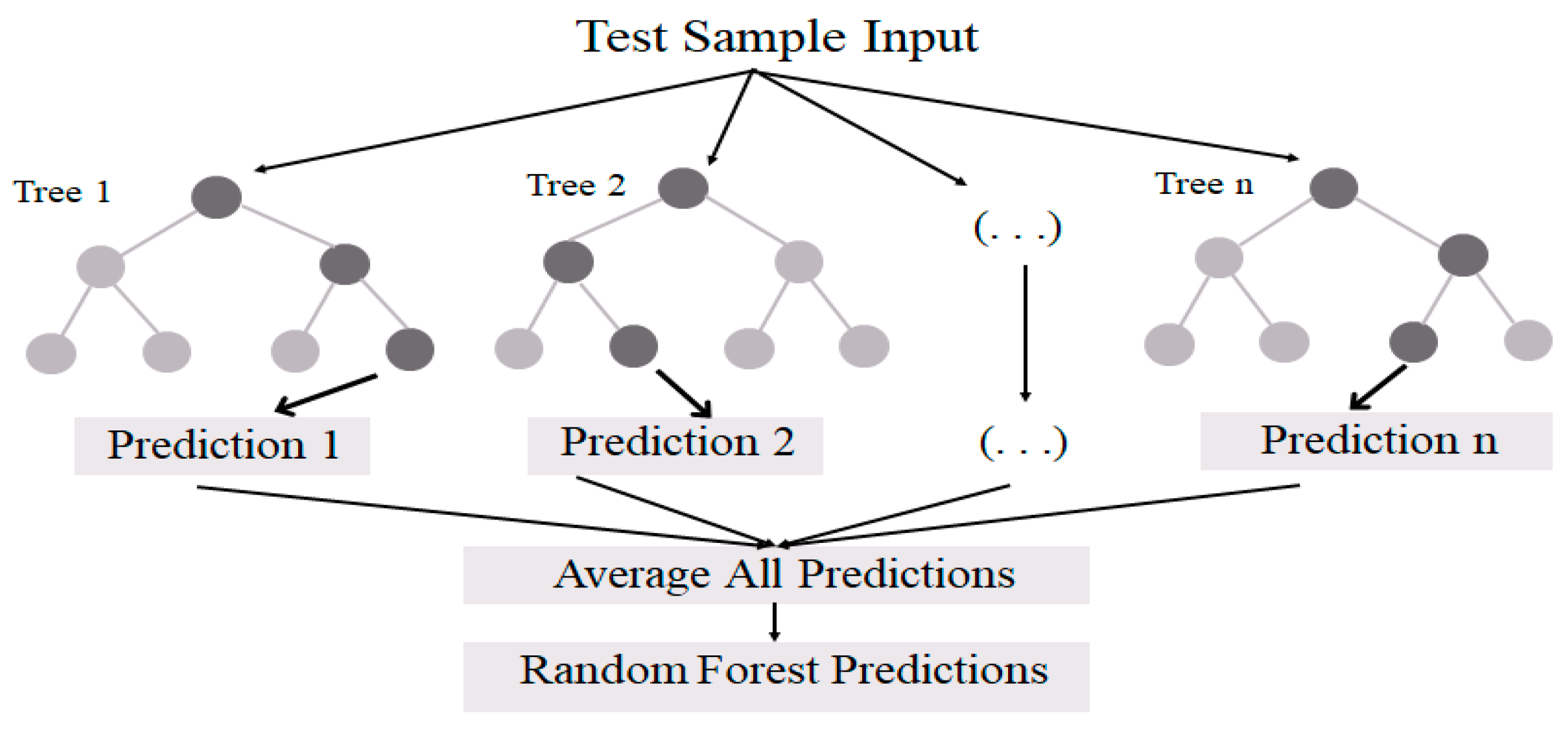
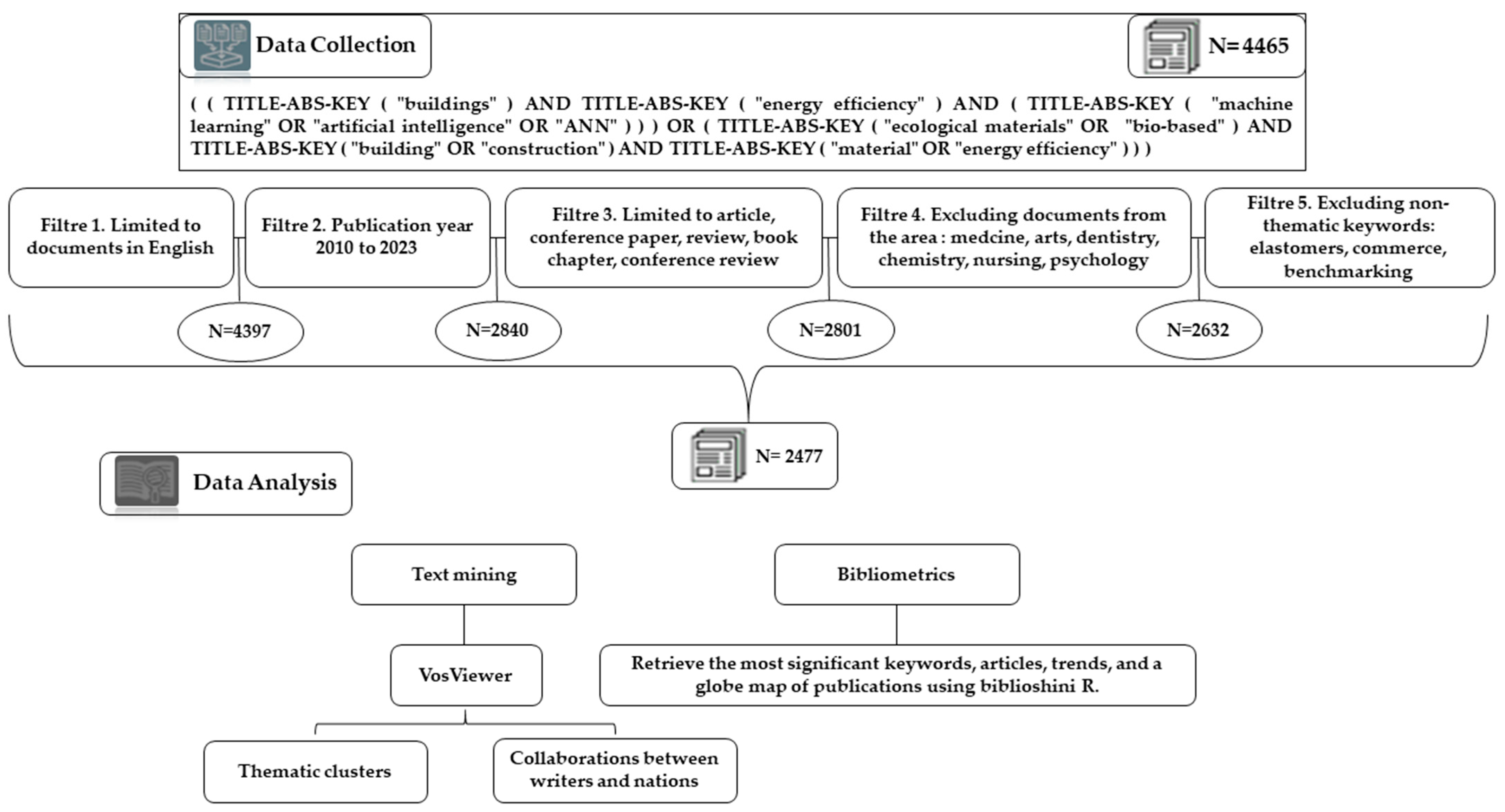


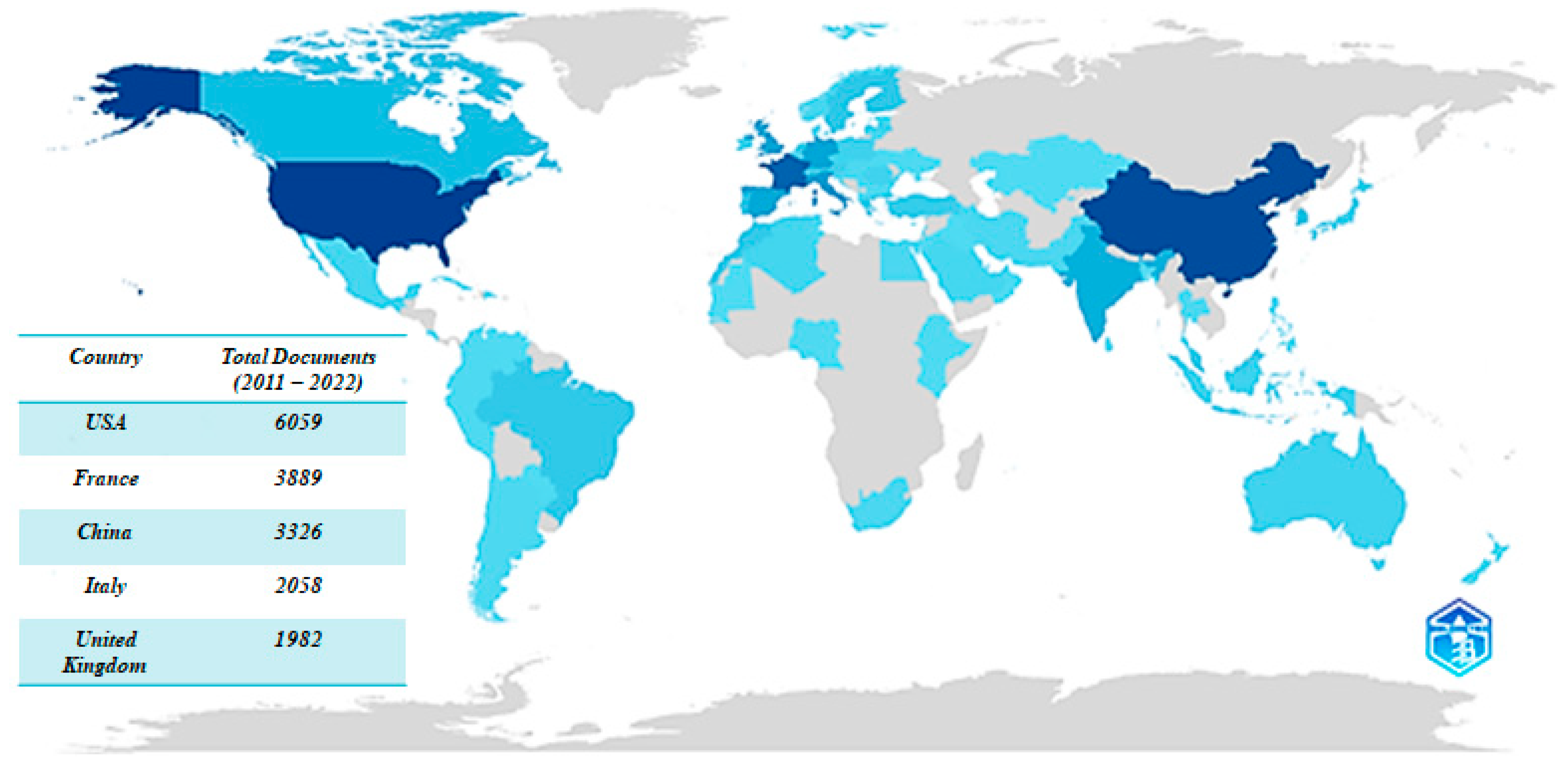
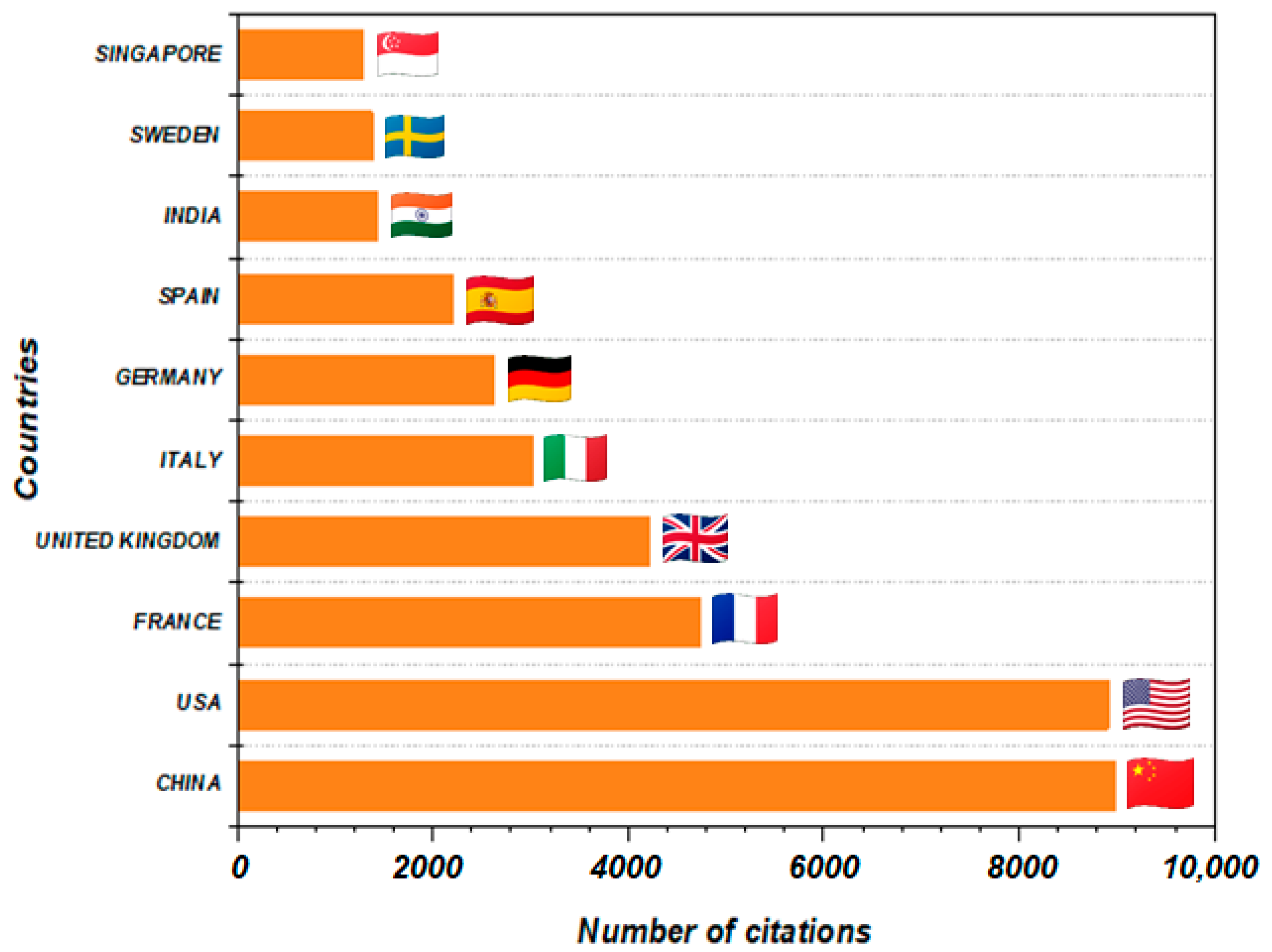
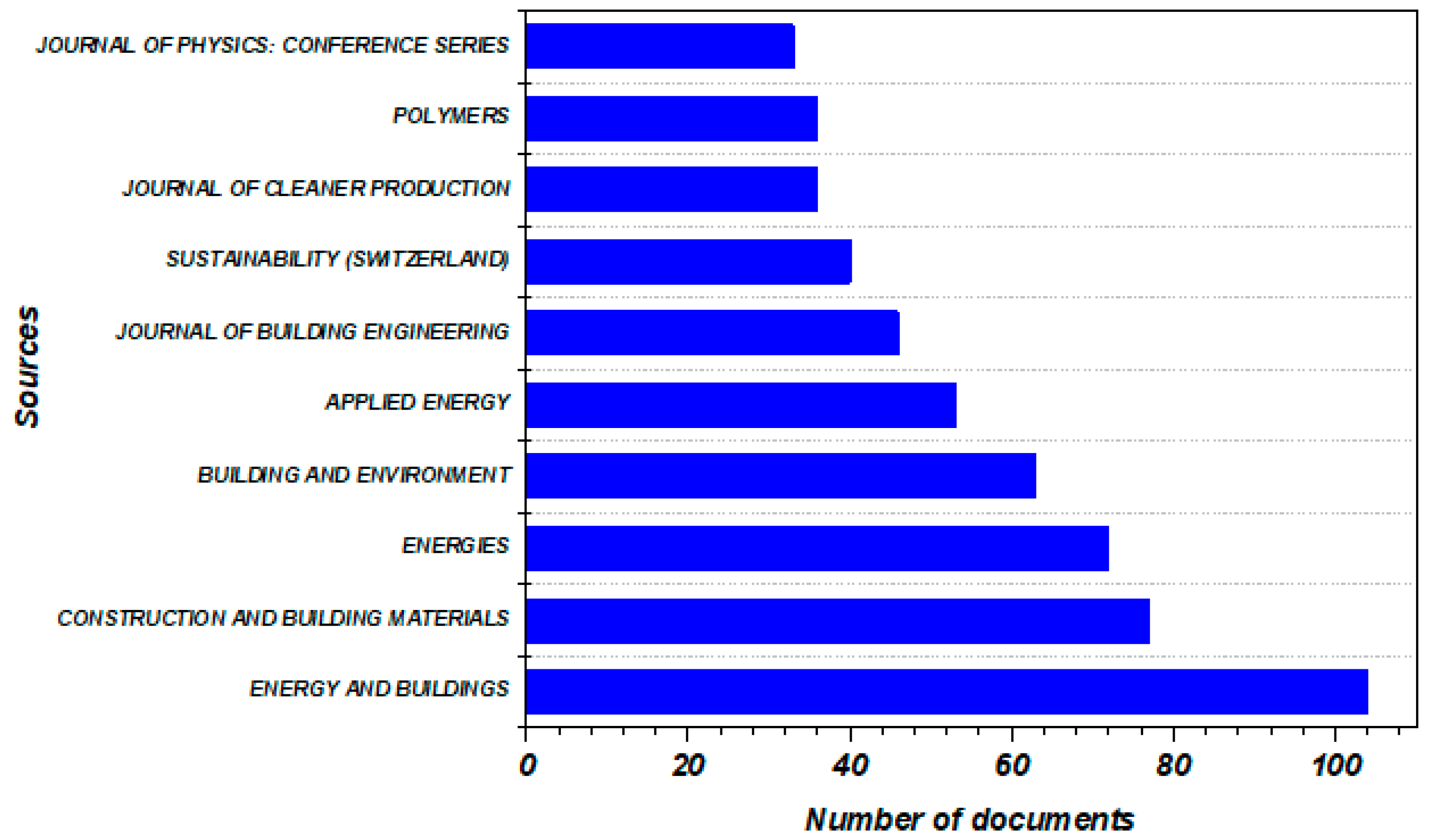
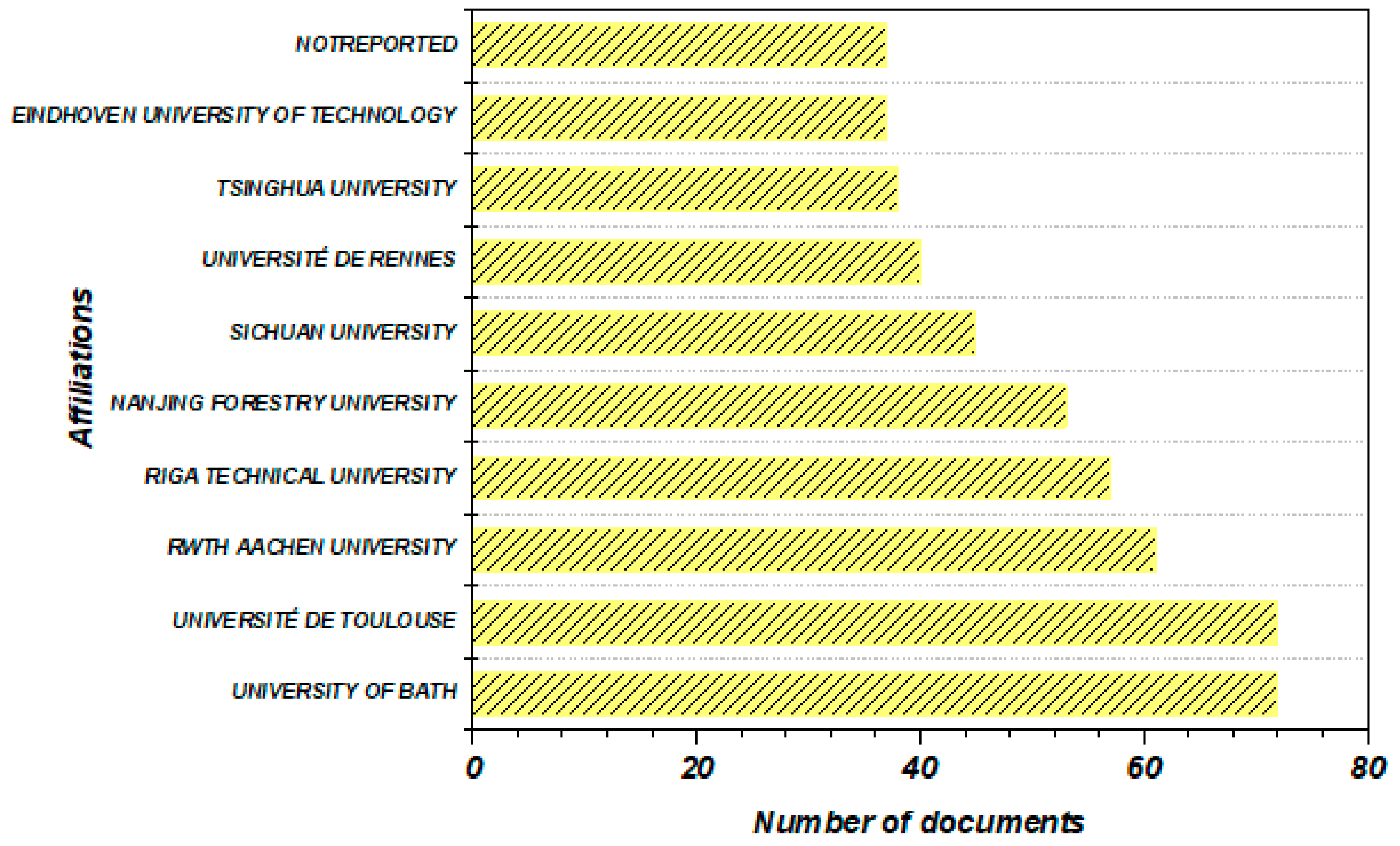

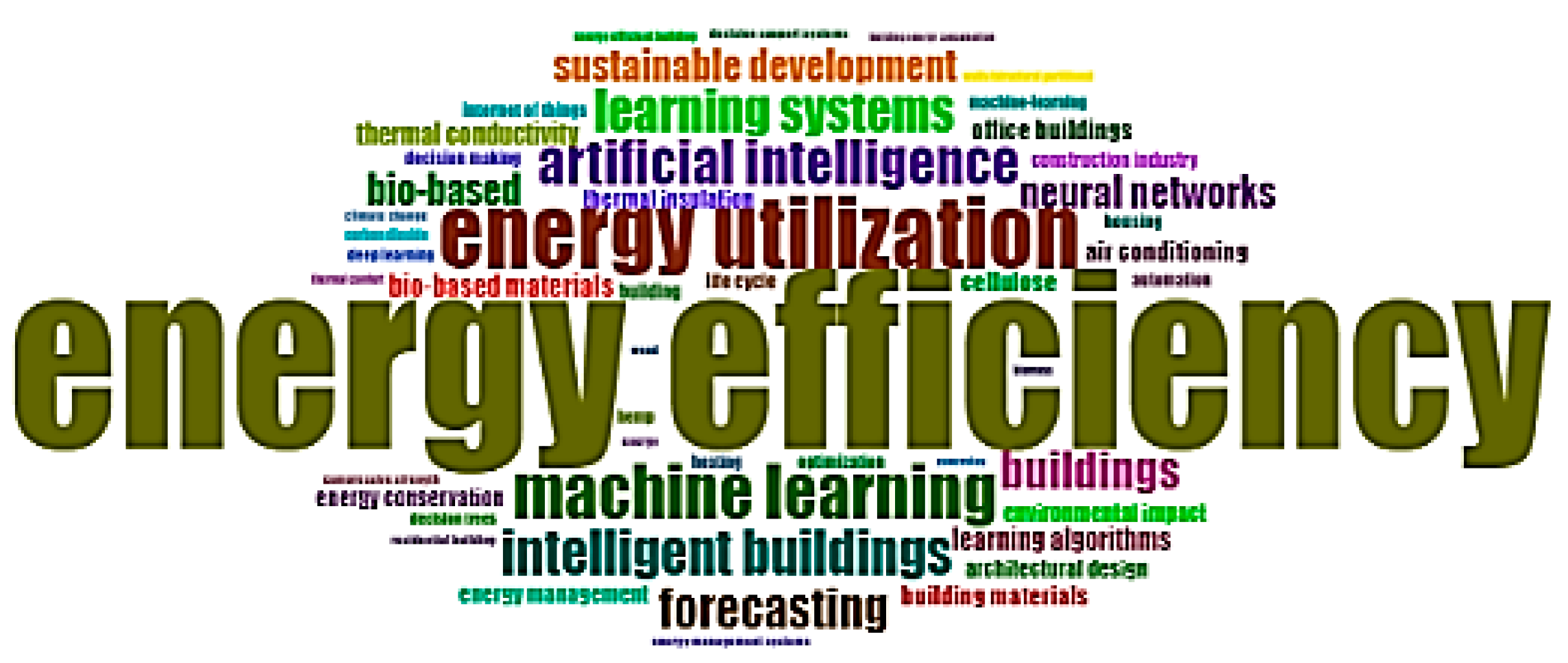

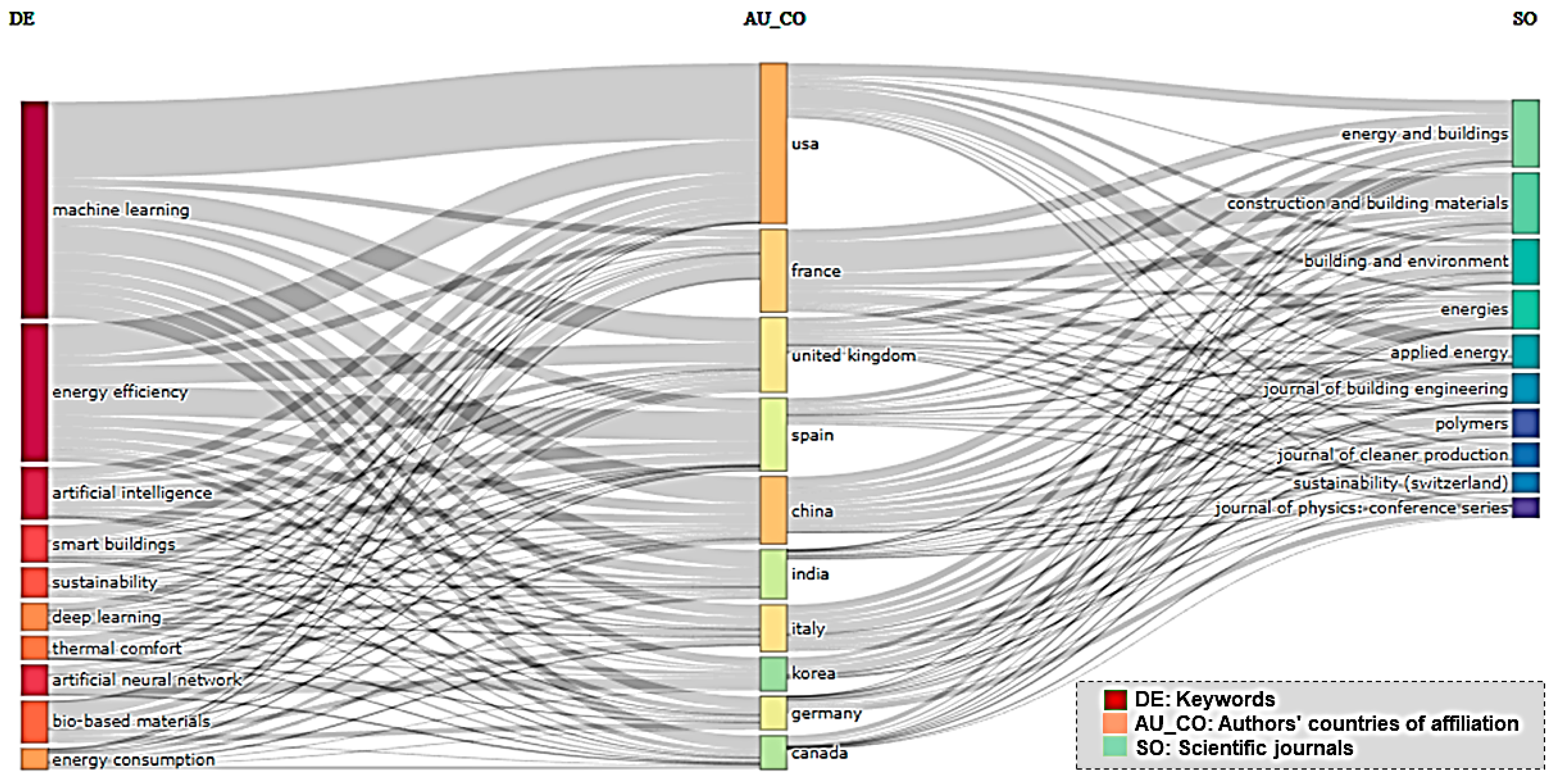
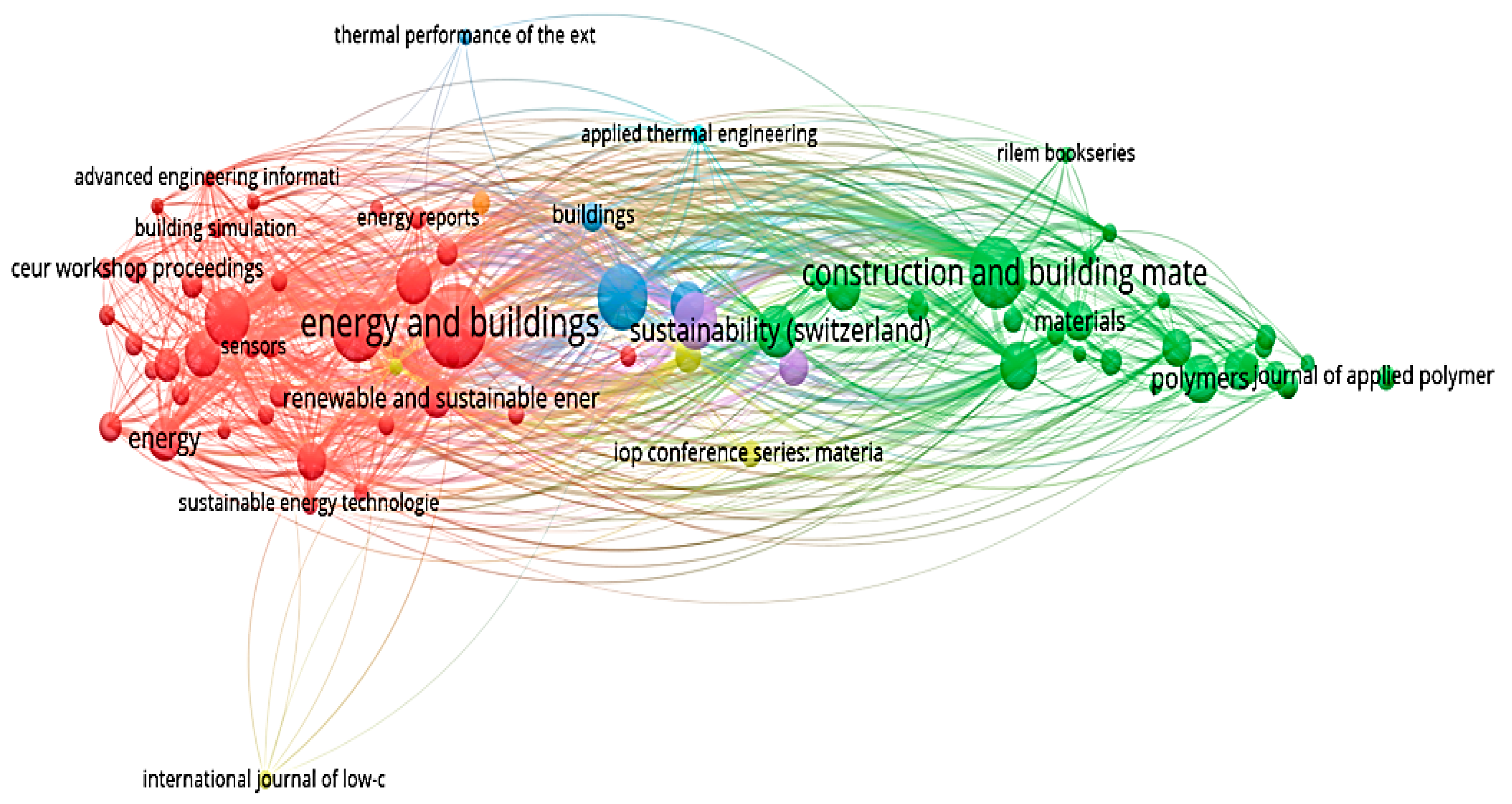
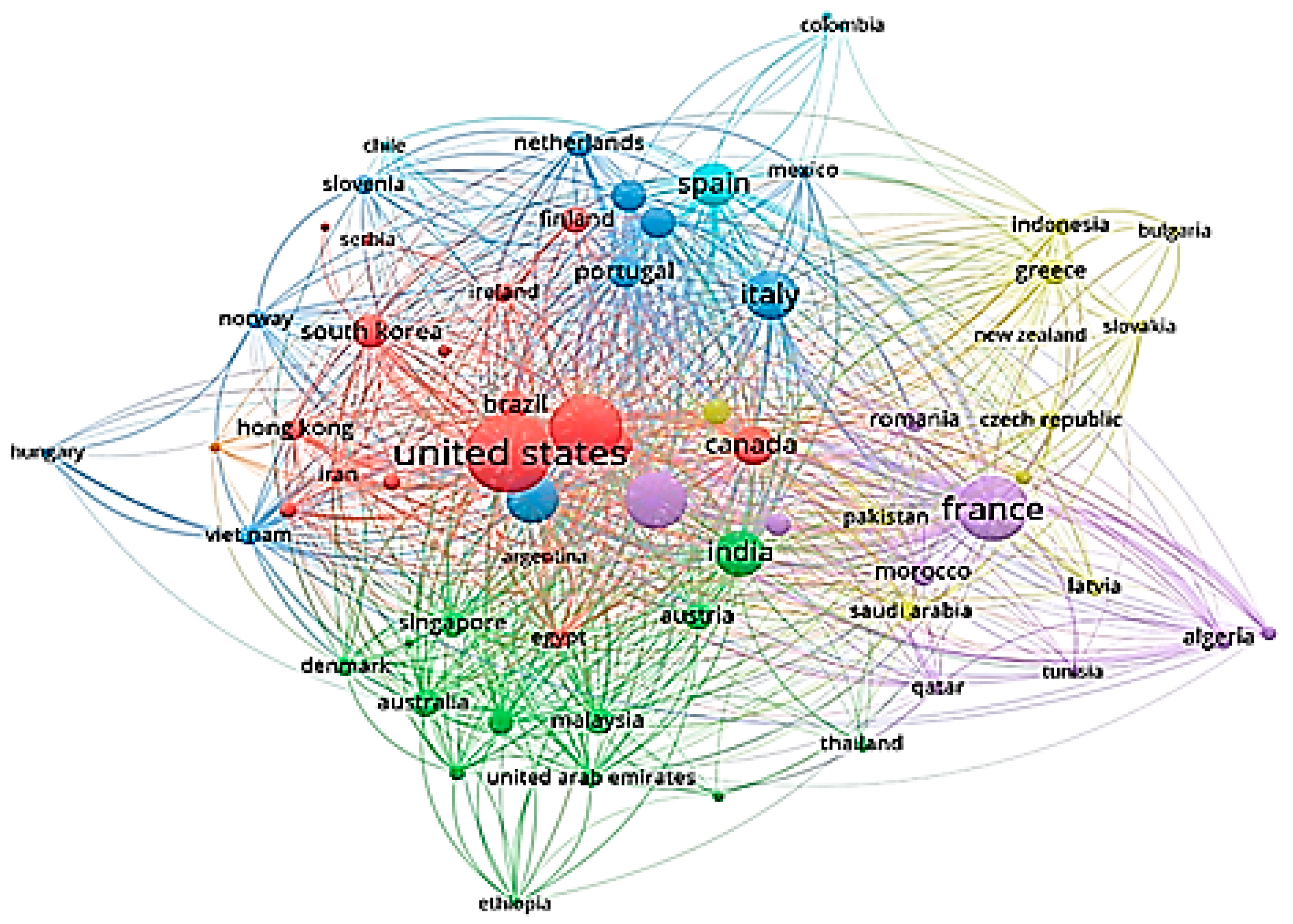
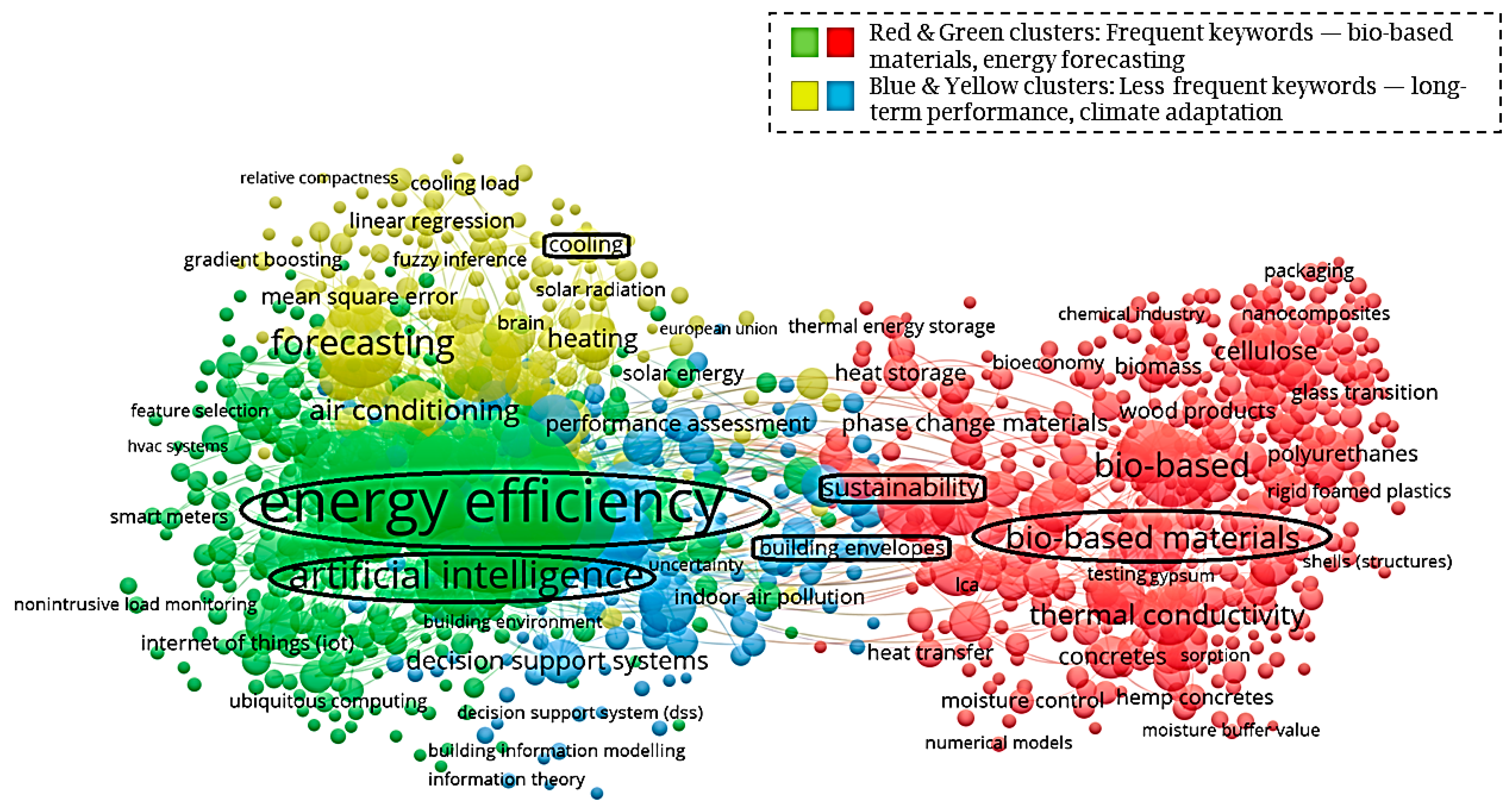
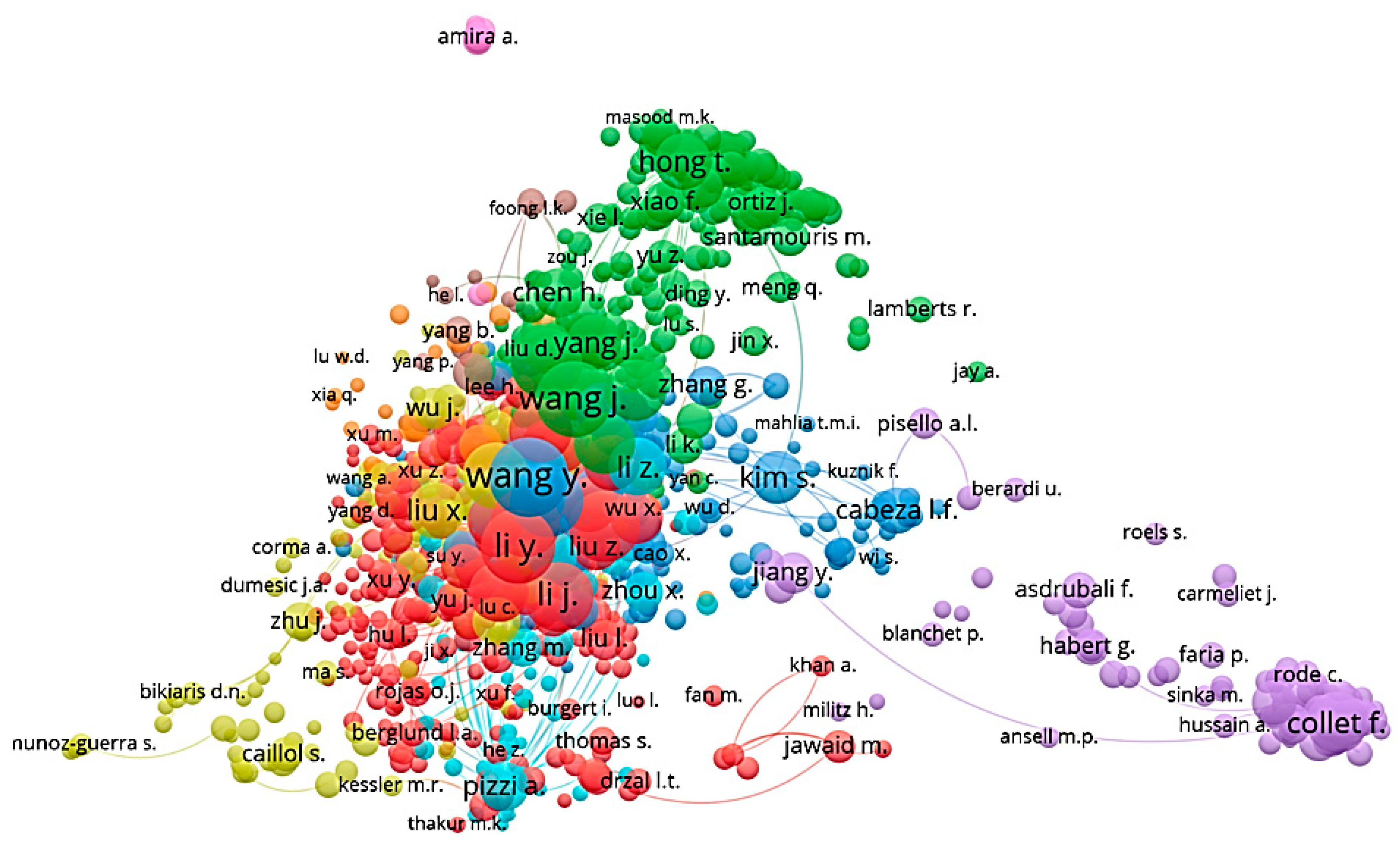
| Journal | Publications | Citations | H-Index | G-Index | M-Index |
|---|---|---|---|---|---|
| Energy and Buildings | 104 | 7672 | 49 | 86 | 3.5 |
| Applied Energy | 53 | 5420 | 38 | 53 | 3.17 |
| Building and Environment | 63 | 2818 | 31 | 52 | 2.82 |
| Construction and Building Materials | 77 | 2547 | 29 | 47 | 2.23 |
| Journal of Cleaner Production | 36 | 2053 | 26 | 36 | 2.36 |
| Energies | 72 | 1461 | 21 | 35 | 1.5 |
| Renewable and Sustainable Energy Reviews | 21 | 3544 | 21 | 21 | 2.1 |
| Journal of Building Engineering | 46 | 1346 | 20 | 35 | 2.22 |
| Energy | 30 | 1584 | 19 | 30 | 1.9 |
| Polymers | 36 | 2175 | 19 | 36 | 1.73 |
| Author | Publications | Citations | H-Index | G-Index | M-Index |
|---|---|---|---|---|---|
| Moon Jin Woo | 15 | 337 | 12 | 15 | 0.92 |
| Magniont Camille | 15 | 580 | 11 | 15 | 1.1 |
| Collet Florence | 14 | 614 | 10 | 14 | 0.83 |
| Habert Guillaume | 16 | 670 | 10 | 16 | 1.11 |
| Lawrence Mike | 10 | 297 | 10 | 10 | 0.83 |
| Walker Pete | 13 | 353 | 10 | 13 | 0.83 |
| Laborel-Préneron Aurélie | 12 | 427 | 9 | 12 | 0.9 |
| Langlet T. | 13 | 414 | 9 | 13 | 0.9 |
| Lanos Christophe | 12 | 398 | 9 | 12 | 0.75 |
| Pretot S. | 12 | 538 | 9 | 12 | 0.75 |
Disclaimer/Publisher’s Note: The statements, opinions and data contained in all publications are solely those of the individual author(s) and contributor(s) and not of MDPI and/or the editor(s). MDPI and/or the editor(s) disclaim responsibility for any injury to people or property resulting from any ideas, methods, instructions or products referred to in the content. |
© 2025 by the authors. Licensee MDPI, Basel, Switzerland. This article is an open access article distributed under the terms and conditions of the Creative Commons Attribution (CC BY) license (https://creativecommons.org/licenses/by/4.0/).
Share and Cite
Fellah, M.; Ouhaibi, S.; Belouaggadia, N.; Mansouri, K.; Younsi, Z. Harnessing AI and Sustainable Materials for Greener, Smarter Buildings: A Bibliometric Study. Buildings 2025, 15, 3777. https://doi.org/10.3390/buildings15203777
Fellah M, Ouhaibi S, Belouaggadia N, Mansouri K, Younsi Z. Harnessing AI and Sustainable Materials for Greener, Smarter Buildings: A Bibliometric Study. Buildings. 2025; 15(20):3777. https://doi.org/10.3390/buildings15203777
Chicago/Turabian StyleFellah, Mohammed, Salma Ouhaibi, Naoual Belouaggadia, Khalifa Mansouri, and Zohir Younsi. 2025. "Harnessing AI and Sustainable Materials for Greener, Smarter Buildings: A Bibliometric Study" Buildings 15, no. 20: 3777. https://doi.org/10.3390/buildings15203777
APA StyleFellah, M., Ouhaibi, S., Belouaggadia, N., Mansouri, K., & Younsi, Z. (2025). Harnessing AI and Sustainable Materials for Greener, Smarter Buildings: A Bibliometric Study. Buildings, 15(20), 3777. https://doi.org/10.3390/buildings15203777






